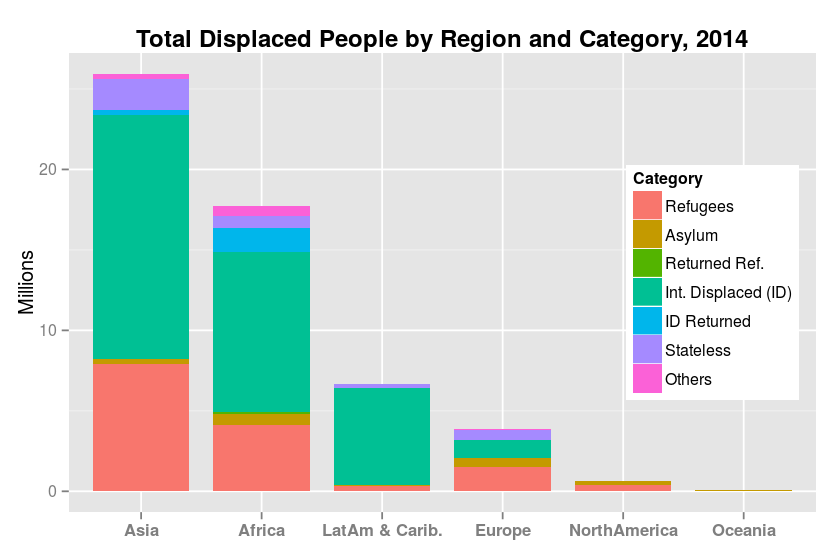A few weeks ago, the office of the UN High Commissioner for Refugees, UNHCR, published its latest report on the current status of people who have been displaced from their homes and lands. Although I have not closely tracked down these reports in the past, my interest on the subject has been increasing over time in part due to the situation of displaced people in Syria, Iraq, and Colombia, to name a few countries where I have worked in the past.
The way mainstream media usually reports on these findings tends to lump all displaced people into one single category, that of refugees, perhaps with the idea is simplifying the context. That approach might work for the average consumer but certainly does not do any justice to the people who have been uprooted from their homes. It turns out things are not as simple as that as we can see on the graph below.
 UNHCR has developed a classification system that distinguishes between five main categories. They are refugees, internally displaced people (IDP), stateless people, people seeking asylum, and others. Two other categories capture the number of IDPs and refugees that have returned to their home and land. Being that as it may, the first key point here is that IDP and refugees together constitute almost 85% of the total number of people displaced on a global scale. Furthermore, IDPs are the main category of all and account for nearly 60% of all displaced people. As a matter of fact, for every refugee, we can find 2.25 IDPs. All the other categories are relatively minor in comparison. While one could certainly think IDPs are in fact “internal refugees” there is no legal recourse for the former to apply for refugee status in their own countries.
UNHCR has developed a classification system that distinguishes between five main categories. They are refugees, internally displaced people (IDP), stateless people, people seeking asylum, and others. Two other categories capture the number of IDPs and refugees that have returned to their home and land. Being that as it may, the first key point here is that IDP and refugees together constitute almost 85% of the total number of people displaced on a global scale. Furthermore, IDPs are the main category of all and account for nearly 60% of all displaced people. As a matter of fact, for every refugee, we can find 2.25 IDPs. All the other categories are relatively minor in comparison. While one could certainly think IDPs are in fact “internal refugees” there is no legal recourse for the former to apply for refugee status in their own countries.
So which are the regions that happen to have the most displaced people? The figure below shows that Asia (which in UNHCR’s definition includes the Middle East) and Africa lead here with a total of more than 43 million displaced people – or almost 80% of all displaced people.
 Note also that refugees outnumber IDPs only in Europe and North America. And in Latin America and the Caribbean, IDPs constitute more than 99% of the total for that region.
Note also that refugees outnumber IDPs only in Europe and North America. And in Latin America and the Caribbean, IDPs constitute more than 99% of the total for that region.
Digging a bit more on the data and looking at the subregions, we get a more nuanced view of the situation, as seen in the chart below.
While the Middle East, East, and Central Africa and South West Asia are among the top five subregions, all with more than 5 million displaced people, we also see that Latin America, sans the Caribbean, is part of this selected group. We also note that in South West Asia the number of refugees is larger than the number of IDPs. In any event, it seems clear that specific subregions are the ones triggering the large numbers in the leading regions.
What about countries? The figure below presents the top 20 countries that have the most displaced people in any of the categories defined by UNHCR.
While Syria is tops on IDPs, Turkey has the lead when it comes to refugees, Pakistan seems to be in a unique situation as it has a similar (and large) number of both refugees and IDPs. When it comes to stateless people, Myanmar comes first. We can once again corroborate that IDPs are the main form of displacement in most 20 top countries. While displaced people is most regions and subregions come from several countries, the same cannot be said for Latin America and the Caribbean. Here, Colombia is the indisputable leader of the region with over 6 million IDPs. That is, 1 of every 11 displaced people lives in Colombia. And according to the latest UNHCR data, the number of IDPs in that country has increased by more than half a million people in the last two years or so, in spite of the peace process and the alleged suppression of paramilitary groups.
All in all, when it comes to refugees, IDPs are the main scourge. And technically and legally, IDPs are not refugees. National governments are thus directly responsible for the future of IDPs and should develop adequate policies and programmes to deal with this social tragedy.
Cheers, Raúl



